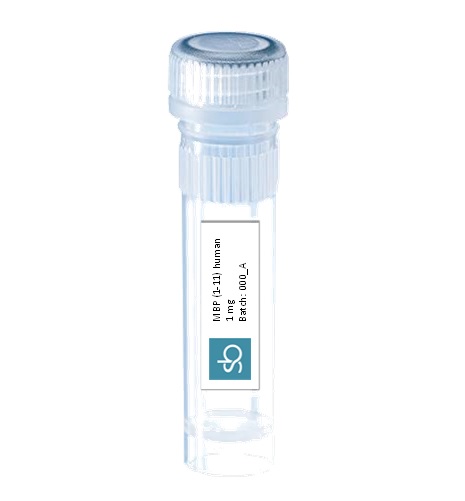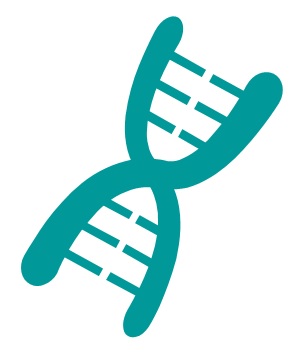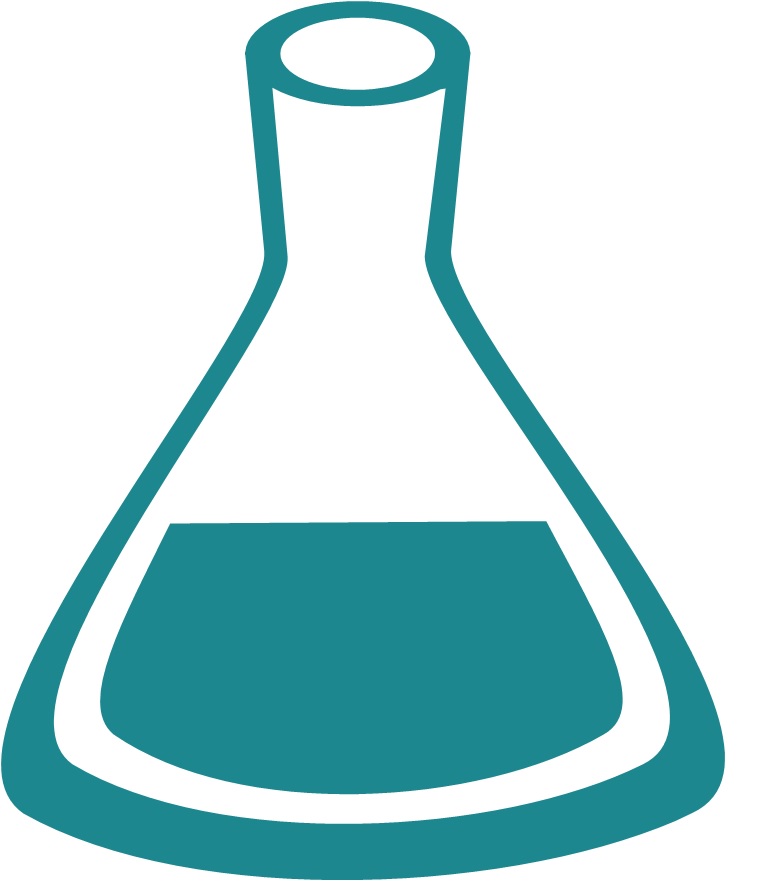MBP (1-11) human: Ac-ASQKRPSQRHG
CAS 106128-98-7
Myelin Basic Protein (MBP)
MBP (Myelin Basic Protein – UniProtKB – P02686) is a major constituent of the myelin sheath of oligodendrocytes and Schwann cells,important in the process of myelination of nerves in the CNS (Central Nervous System). This protein permits the maintain of the myelin structure. Antibodies against Myelin Basic Protein has shown a role in the pathogenesis of MS (Multiple Sclerosis). That made MBP an important antigen for the studies of demyelinating diseases.
MBP (1-11) for EAE induction
The MBP1-11 peptide is a major encephalitogenic epitope of myelin basic protein used experimentally to induce EAE (experimental autoimmune encephalomyelitis).

MBP1-11 specifications
 |
Sequence : Ac-ASQKRPSQRHG – Purity : > 95% |
 |
MW : 1293.39 g / mol (C52H88N22O17) |
 |
For research use |
 |
Counter-Ion : TFA Salts (see option TFA removal) |
 |
Delivery format : Freeze dried in polypropylene 2mL microtubes |
 |
Other names : ac-asqkrpsqrhg; mbp (1-11) human; acetyl-mbp (135-145) (human); ac-mbp (human ,porcine ,rat 1-11); myelin basic protein (135-145) ,human; acetyl-golli-mbp1 hog7 (135-145) (human); acetyl-myelin a1 protein (135-145) (human),CAS 106128-98-7 |
 |
Peptide Solubility Guideline |
 |
Bulk peptide quantities available |
Related MBP1-11 products
Price
| Product catalog | Size | Price € HT | Price $ USD |
| SB0142-1MG | 1 mg | 110 | 138 |
| SB0142-5MG | 5 mg | 385 | 481 |
References
J Neuroimmunol . 1996 Dec;71(1-2):3-10. doi: 10.1016/s0165-5728(96)00107-5
Prior exposure to superantigen can inhibit or exacerbate autoimmune encephalomyelitis: T-cell repertoire engaged by the autoantigen determines clinical outcome
Experimental allergic encephalomyelitis (EAE) is inducible in experimental animals immunized with myelin basic protein (MBP),proteolipid protein (PLP) or their peptides. We compared T-cell responses to encephalitogenic epitopes of PLP(43–64) and MBP(Ac1–11) in a single mouse strain,(PL/J × SJL)F1. MBP(1–11)-specific T-cell hybridomas expressed predominantly TCR Vβ8 or Vβ4,while PLP(43–64)-specific hybridomas expressed a diverse TCR repertoire. To analyze the biologic significance of the TCR repertoire (limited vs. diverse) to disease susceptibility,we pretreated mice with a superantigen (SEB),and then induced disease with these autoantigens. Mice injected with SEB and immunized with MBP(Ac1–11) showed significant inhibition of EAE,whereas SEB-pretreated mice immunized with PLP(43–64) had an increased severity of EAE and developed a chronic disease. These data demonstrate that prior exposure to microbial superantigens can significantly alter the autoimmune disease course depending upon the TCR repertoire used by the autoantigen.
J Immunol . 1987 Aug 15;139(4):1075-9
T cell specificity for class II (I-A) and the encephalitogenic N-terminal epitope of the autoantigen myelin basic protein. | The Journal of Immunology
The role of class II restriction in T cell recognition of an epitope of the autoantigen myelin basic protein (MBP) has been investigated. Encephalitogenic PL/J(H-2u) and (PL/J X SJL/J(H-2s))F1 ((PLSJ)F1) clones,isolated after immunization with intact MBP,recognize the N-terminal 11 amino acid residues of MBP in association with I-Au class II molecules. The synthetic peptide MBP 1-11 has been tested in vivo for induction of EAE. Clinical and histological EAE occurs in PL/J and (PLSJ)F1 mice but not SJL/J. The class II restriction of T cells primed with MBP 1-11 has been examined in primary cultures in vitro. Similar to encephalitogenic T cell clones,isolated after continuous selection in vitro,the population of MBP 1-11-specific proliferative PL/J and (PLSJ)F1 T cells,recognize this epitope in association with I-Au class II molecules. Not all MBP-specific T cell clones which are restricted to I-Au class II molecules cause autoimmune encephalomyelitis. The specificity of these non-encephalitogenic clones has been examined in this report. These clones also recognize MBP 1-11. Thus recognition of an encephalitogenic T cell epitope is not sufficient for induction of EAE.
Autoimmunity . 1999;31(4):237-48. doi: 10.3109/08916939908994069
Immunoregulation of encephalitogenic MBP-NAc1-11-reactive T cells by CD4+ TCR-specific T cells involves IL-4,IL-10 and IFN-gamma
The generation of TCR transgenic (Tg) mice expressing a BV8S2 (Vbeta8 subfamily 2) chain specific for the encephalitogenic NAc1-11 region of MBP provides a unique system for evaluating the mechanisms involved in anti-TCR immunoregulation of EAE. In a previous study,we showed that vaccination with BV8S2 protein induced specific T cells that inhibited proliferation responses and encephalitogenic activity of MBP-reactive T cells in vitro,and resulted in a skewed production of Th2 cytokines by the MBP-reactive T cells. These data suggested that regulation of the encephalitogenic T cells was mediated by inhibitory cytokines rather than through a deletional mechanism. In the current study,we have employed the BV8S2 Tg mouse model to address the issue of which cytokines produced by anti-TCR-reactive T cells can regulate the function of encephalitogenic Th1 cells. Utilizing neutralizing anti-cytokine antibodies to reverse inhibitory effects of supernatants from BV8S2-specific T cells,we found that IL-4,IL-10,and to a lesser extent,IFN-gamma and TGF-beta,were the major regulatory cytokines responsible for inhibiting encephalitogenic activity,proliferation,and IFN-gamma secretion of MBP-NAc1-11-reactive Th1 cells. These results indicate that cytokine regulation is the major mechanism through which TCR specific CD4+ T cells regulate encephalitogenic and potentially other bystander Th1 cells.
